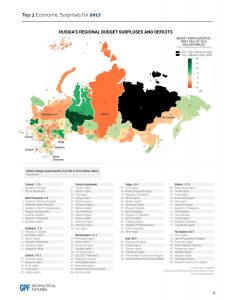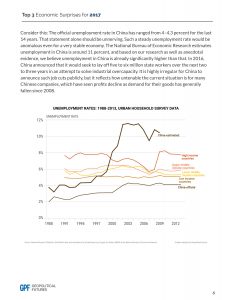 By George Friedman
By George Friedman
We have been slaving away at our 2017 forecast for over two months now, and we are excited to share it with the world. Only subscribers to Geopolitical Futures can access the full 24- page document, but we wanted to take a step back and pick out the three most important economic surprises that await the world in the year ahead, for a select group outside our current membership. Obviously, we want you to consider subscribing to our service if you haven’t already, but we also feel a responsibility to share some of our most important forecasts more broadly because of how critical we expect these developments to be.
You will note that these forecasts run counter to most mainstream expectations. That does not bother us in the slightest. We have become accustomed to being called all sorts of names when our predictions first appear… and then watching the surprise of doubters when the predictions come true. The media has become an echo chamber that amplifies unhelpful assertions of global groupthink. GPF aims to be the voice heard over the echo, and in 2017, that voice is calling you to think about the possible ramifications of three key developments: a contraction of exports in Germany, the beginning of a long-term decline in the Russian economy, and an increase in unemployment rates in China.
Germany
The global crisis of exporters is about to shift into higher gear. The world got here via the 2008 financial crisis, an unwanted gift that seems to keep on giving. Events in 2008 resulted in decreased demand for Chinese exports in Europe and the United States. This posed a severe problem for China, undermining Chinese profit margins but also curtailing Chinese imports (especially industrial commodities). Countries that were dependent on the export of these commodities saw their profits begin to shrink. Growth remained stagnant in Europe and moderate, at best, in the U.S., creating a cycle whose effects have played out throughout the global economy.
Four major countries were most vulnerable to this vicious circle: China, Germany, Russia and Saudi Arabia. Together, those countries make up more than one-fifth of the world’s GDP. China, Russia and Saudi Arabia have already shown disturbing signs of this crisis manifesting in their national economies, which has led to political instability and economic volatility. Germany has conspicuously avoided the worst effects of the crisis thus far. But this will not continue in 2017. Next year, the global exporters’ crisis will visit Germany—the world’s fourth-largest economy, Europe’s largest economy, and the third-largest exporter in the G-20 – in earnest.
German exports in 2016 have been lower than projected. According to Destatis (based on the latest statistics available), German exports grew by only 0.8 percent in 2016, compared to 2015. The Deutsche Bundesbank admits that prospects for German exports have become “less favorable,” but it still expects German exports to grow moderately in 2017 and 2018.
We beg to differ. Europe will continue to see anemic growth rates, and other major problems face the European Union besides struggles in the German economy, which will weigh down growth. The U.S. economy will grow moderately at best, and by the end of 2017, it may approach a cyclical recession. Germany was able to compensate for reduced Chinese demand for German exports by increasing trade with the U.S. and the United Kingdom. Chinese demand will continue to decrease, and the U.S. and U.K. won’t be able to pick up the slack for German exports forever. German banks are already showing signs of strain, and we expect investment and employment in the industrial sector to slow down in 2017. Because 47 percent of Germany’s GDP comes from exports, this will amount to nothing less than a crisis for Germany, with negative economic and political implications for other European countries. For more about those implications, you’ll have to read the full report, but suffice it to say that the key economic event in Europe will be Berlin’s exports coming home to roost.
Russia

It is no secret that Russia has been struggling mightily since the collapse of global oil prices that began in August 2014. In 2008, oil alone accounted for 18 percent of the Russian economy, and the average price was $91.48 a barrel. Russia thought it was being responsible when it planned its government budgets with oil prices at $82 a barrel, but it didn’t expect prices to drop as precipitously as they have. The average oil price in 2016 is $43 a barrel. The ruble has hit alltime lows against the dollar, inflation in Russia at one point in 2015 was over 16 percent, and the International Monetary Fund (IMF) estimates Russia’s GDP will contract 1.2 percent in 2016. The graphic below shows how dire the situation is by identifying all the regions in Russia that operated at a budget deficit in the first half of 2016.
Curiously to us, however, the world seems to think that Russia has already hit rock bottom and that a recovery will slope upward from here. A July 2016 IMF report on Russia stated: “Growth is expected to resume in 2017 and reach 1 percent, as domestic demand slowly recovers on the back of easing financial conditions and pent up demand.” The IMF obviously doesn’t know what rock bottom looks like in Russia. As oil prices go, so goes the Russian economy, and we have no reason to believe oil prices are going to increase much in 2017. A recent compromise reached by OPEC was more like staunching a bleeding wound than curing the underlying problem of global oversupply. On top of this, Russia is continuing to spend large amounts of money on military modernization while cutting social spending by as much as 10 percent across the board.
Whatever the exact numbers for Russia’s GDP, they are ultimately of little importance – we expect contraction, but even if there is some growth, 2017 will be an extremely difficult year for the Russian economy and, therefore, the Russian people. We have already observed some disturbing signals that this economic problem is beginning to manifest in social and political unrest, and we expect to see much more of that in the year ahead. In our forecast through 2040, we describe how we believe that by that time, the Russian Federation will have ceased to operate as a federation. The best-case scenario will resemble a loose confederation, and the worst could involve the genuine secession of various regions. 2017 is not the year Russia will fall, but it will be the year that the contours of the abyss ahead become clear. The long Russian winter is coming, and in hindsight, 2017 will be viewed as a significant turning point in Russia’s history. All of this will have important ramifications on Russia’s place in the world, which is detailed in our full forecast.
China

Last, and certainly not least, is China. 2016 turned out to be the year the world realized that what GPF founder George Friedman has been saying about China for years really was true: China’s preternatural growth rates could not be sustained forever. Eventually, the Chinese growth miracle would come to an end, and China would face a choice – the imposition of a dictatorship or a collapse into the regionalism that has defined much of Chinese history. The dictatorship of President Xi Jinping has been advancing for some time, and 2017 will be the year that Xi eliminates the last of his rivals and solidifies his control over the political system. This will be necessary because as China’s underlying economic problems continue to mount, unemployment will begin to rear its head, and that is an extremely dangerous problem for the stability of China’s political system. Top 3 Economic Surprises for 2017 6
Consider this: The official unemployment rate in China has ranged from 4–4.3 percent for the last 14 years. That statement alone should be unnerving. Such a steady unemployment rate would be anomalous even for a very stable economy. The National Bureau of Economic Research estimates unemployment in China is around 11 percent, and based on our research as well as anecdotal evidence, we believe unemployment in China is already significantly higher than that. In 2016, China announced that it would seek to lay off five to six million state workers over the next two to three years in an attempt to solve industrial overcapacity. It is highly irregular for China to announce such job cuts publicly, but it reflects how untenable the current situation is for many Chinese companies, which have seen profits decline as demand for their goods has generally fallen since 2008.
A number of potential problems face the Chinese economy in 2017, including a looming housing bubble, the devaluation of the yuan and rising debt. But the most serious of these is unemployment. China has always valued social stability over bottom lines on balance sheets, and that is because China is such a large and unwieldy place to govern. The problem is China’s economy has reached the limits of its high-growth, low-wage economic model, and it is now trying to transition toward a consumer economy. Making such a change for any economy is difficult, and for one that is as diverse as China’s and that has grown at such a fast rate, it will be even harder. China is trying to find a balance between making those reforms and pumping money into growth strategies that keep people employed, but the seams have begun to fray.
As with Russia, we don’t expect 2017 to challenge the rule of the government. But we do expect Xi’s crackdowns on potential opposition to increase in intensity, and this will be as a result of serious stresses on the Chinese economy, chief among them a concealed but no less real increase in those without jobs in China. How this will be reflected in Chinese foreign policy and in the U.S.- China relationship in the wake of Donald Trump’s election in the U.S. is all addressed at length in our full forecast.
What This Means Geopolitically
Many people think geopolitics is just a fancy word for “international relations” or “foreign policy.” But that’s not the kind of geopolitics we do at Geopolitical Futures. We understand geopolitics to be the intersection between geography and power. Power, in turn, comes in three main forms: military, economic and political. Our forecasts look at all of these components and how they work with and against each other in shaping the future of the world. No one component is necessarily more important than the other – it’s the context that gives global events meaning. Above, we summarized our three most important economic forecasts for the year. But as important as these three forecasts are, without geopolitics, you are missing the full picture. The ramifications of these developments, along with the rest of our geopolitical predictions for 2017, are contained in the 2017 forecast. If this summary has piqued your interest, we encourage you to check it out and consider subscribing
http://www.mauldineconomics.com/download/gpf-top-3-economic-surprises-for-2017



